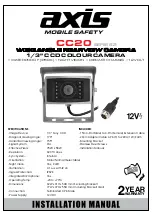
www.marcumtech.com
- 5 -
The Manta camera incorporates internal ballast weights within the camera
housing. The amount of weight is ideal for use while stationary, but when using
from a boat, mounting the supplied tail fin will keep the camera facing straight
ahead. The fin may also be used for down viewing, simply mount the fin on the
back of the camera housing and clip the cable into the special slot in the fin.
The VS385C is protected with a stylish reinforced padded soft pack case.
Under the soft pack is a molded ABS hard case with a built in battery tray and
a hook and loop strap to securely hold the battery in place. Next to the battery
is a storage compartment for the camera and camera cable. The monitor folds
down flat and the padded case encompasses the entire system protecting it
during transportation. On the left side of the case is a carrying handle for ease
of transport.
Getting Started
Remove the VS385C from the packaging and place it on a level surface with
the MarCum Technologies logo facing towards you and right side up. Open
the top cover of the soft pack by lifting up on the hook and loop closers on
each side and front of the soft pack. Once opened, loosen the knobs on
the either side of the gimbal bracket (at the base of the monitor) by turning
each one counter-clockwise. Make sure to loosen the knobs a considerable
distance. Then depress both knobs by pushing inwards and hold in place.
This releases the lock on the monitor angle. While depressing the knobs with
the base of your palms, use the index fingers of each hand and gently lift the
monitor up to the desired viewing position and release tension on the gimbal
knobs. Once you have set the monitor to the desired viewing angle, gently
tighten the knobs until they are snug. The battery, camera and cable are now
accessible behind the monitor. It’s easiest to remove the hook and loop straps
and unzip the soft pack case.
The depth of field (distance the camera can see underwater) depends on the
clarity of the water and available light at the depth the camera is used. In clear
water, the depth of field can be many feet but in cloudy or muddy water the
depth of view can be reduced to only a few inches due to particles suspended
in the water. Dirty or muddy water and/or low light penetration can detract
from the quality of the picture. Optimum picture quality will result from clear
water and adequate light penetration.
If your camera provides a great picture above the water, but the image on the
screen disappears once the camera has been deployed, it is safe to say that
the conditions on that particular body of water are not conducive to underwa-
ter viewing.






























